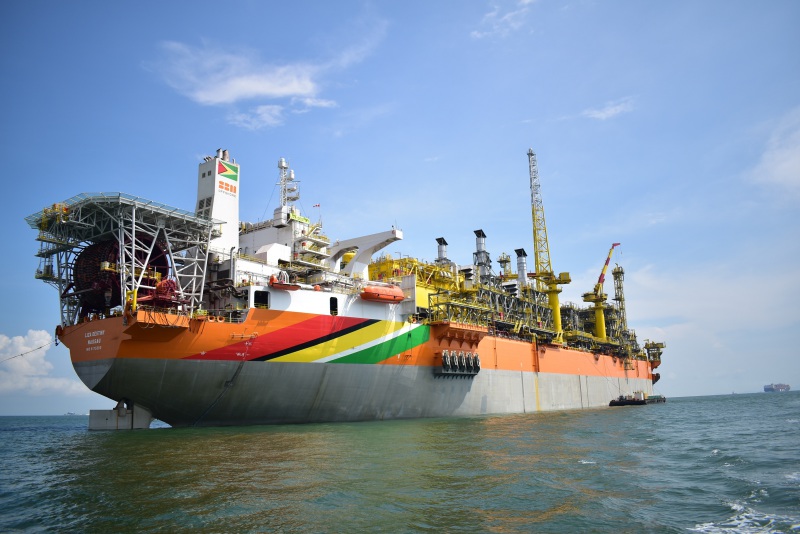Having cut production last week to 30,000 barrels of oil per day because of gas compression problems, ExxonMobil last evening said that it has begun ramping up output and that a solution is at least three months away during which controversial flaring will occur.
Since January this year, ExxonMobil has experienced major problems with the gas compression equipment on its Liza Destiny Floating, Production, Storage and Offloading (FPSO) platform in the Atlantic and this has led to environmentally damaging gas flaring which is now set to continue.
On April 13th, ExxonMobil announced that its third phase of testing of repaired gas compression equipment on the Liza Destiny had failed and that this had resulted in production being slashed to 30,000 barrels.
ExxonMobil said then that it had reduced production to a minimum level that “mitigates formation of hydrates in subsea systems, maintains gas injection and fuel gas to the power generators, and minimizes flare…”
This was followed by a statement from the Ministry of Natural Resources on April 14 expressing disappointment at the continuing gas problems and hinting that action would be taken to “protect (the) national interest”.
The Ministry said then that the government was “highly disappointed” at ExxonMobil’s failure to resolve the gas compressor problem on its oil platform that has led to flaring of gas and a steep drop in production.
The ministry added that the government is “currently examining the implications of the loss of output, and consequently loss of income and revenue, including measures that it may have to institute to protect (the) national interest”. It did not elaborate further but it appears that the government has made it clear that production has to be kept up.
ExxonMobil’s statement yesterday hinted at this.
“We have begun to slowly ramp up production to between 100,000-110,000 barrels per day at a flare level of no more than 15 Mscfd (Million Cubic Feet per Day).
“These operating parameters were defined after careful consideration of safety, environmental, technical and economic factors as well as discussions with the relevant government agencies on the best path forward while repairs and upgrades are ongoing.
“ExxonMobil Guyana is extremely disappointed by these ongoing technical challenges but we are proud of the team offshore that continues to work safely and manage operations efficiently in the COVID-19 pandemic.
“We will continue to work with the relevant parties to rectify the situation as soon as possible”.
Yesterday’s statement from the oil company further said: “Teams on the Liza Destiny FPSO have removed the discharge silencer for further assessment of the damage and to determine the necessary scope of repairs and/or modifications. We estimate that repairs or replacement will take approximately three months. Additionally, plans initiated in 2020 are progressing to install a redesigned third stage flash gas compression system at the end of this year”.
The discharge silencer of the gas compressor system began experiencing technical issues during the final testing phase of the reinstalled flash gas compressor and other components of the system just over a week ago.
“As we conducted the final testing phase of the reinstalled flash gas compressor and other components of the system on the Liza Destiny FPSO, we encountered an additional problem with the discharge silencer. A team from SBM Offshore, MAN Energy Solutions and ExxonMobil are on site to assess repairs, with support from engineering experts in Europe and the USA,” the company disclosed on April 13.
President of ExxonMobil Guyana Alistair Routledge had said that the gas compressor failed in the middle of the night on January 27th this year when optimisation testing was ongoing and the production level was around 130,000 bpd. However, he maintained that this was not in any way linked to the malfunction. Exxon Production Manager Michael Ryan had revealed that it was the mechanical seal that failed, which made the operator realise that there was an issue with the gas compressor.
Following the malfunction, the gas compressor and other key parts from the FPSO were sent to Germany for repairs.
A few weeks ago it was announced that logistics for its departure from Germany were being finalized following the successful completion of repairs, upgrades and mechanical testing of the compressor by MAN Energy Solutions, the equipment’s manufacturer, with quality assurance and control by experts from the vessel’s owner SBM Offshore as well as Exxon.
ExxonMobil has been severely criticised for the resumption of gas flaring above pilot level following problems with the gas compressor.
Specifically the removal of the gas compressor saw oil production pared to 120,000 barrels per day (bpd) – the previously stated maximum capacity of the FPSO – while gas flaring increased to 16 million cubic feet per day.
This is the second time that the gas compressor on the Liza Destiny has malfunctioned with the first being in 2020. However, it is uncertain if the latest failure of the flash gas compressor is linked to the issue that occurred last year.






